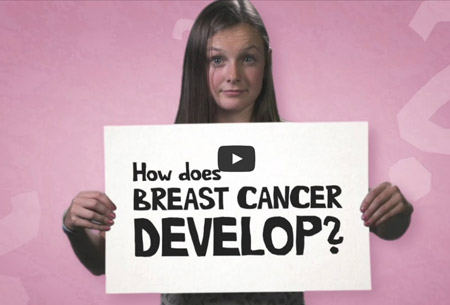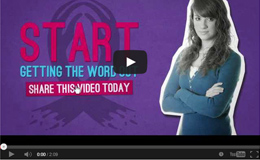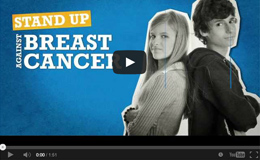

The Science
What is breast cancer?
Breast cancer is the most common cancer in women.
- 1 in 9 (11%) Canadian women will be diagnosed at some point in their life.
- Breast cancer does not just affect older women, young women are at risk too – women as young as 20!
- Over 23,000 Canadian women are diagnosed with breast cancer each year – that’s about 65 women each day!
Breast cancer is a type of cancer that begins when the cells of the breast tissue mutate, or change, and begin to divide and grow in an uncontrolled way. These cells then start to build up and group together, causing a tumor to form. Some tumors are benign, which means they will not invade surrounding tissue. Other tumors are malignant – meaning they are cancerous and can spread to other parts of the body.
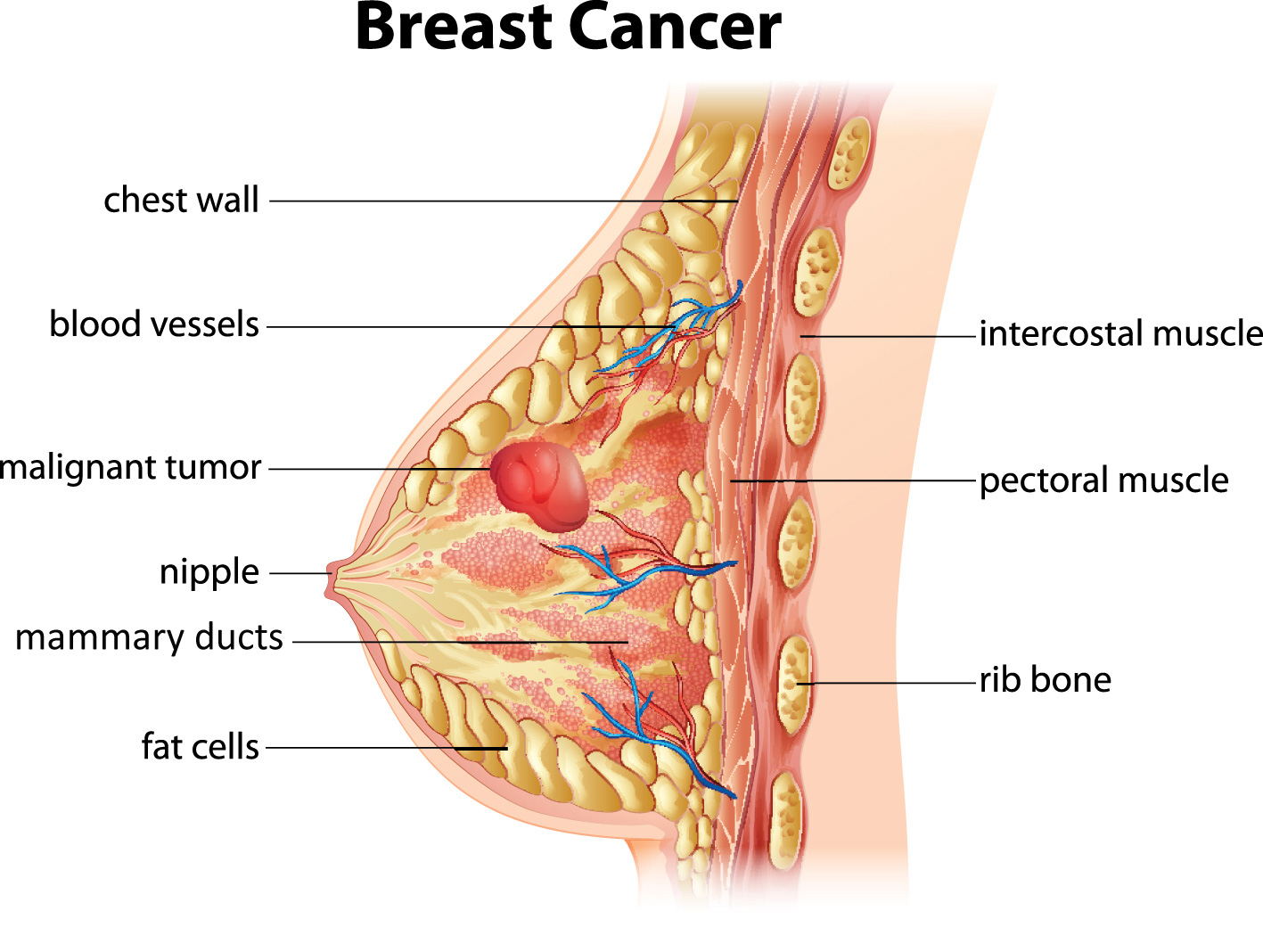
What are the early signs of breast cancer?
Breast health is about being breast aware – knowing what’s normal and watching for breast changes. Some breast changes are normal. For example, when breasts are growing they can feel tight, heavy, and sometimes tender. During monthly periods it is also common to have tender breasts or slight lumpiness. These changes are temporary. Breasts also change as women grow older.
Some changes may be an early sign of breast cancer – like a new lump, pain or tenderness in the breast or armpit not related to your menstrual cycle, and changes in the look and feel of your breasts or nipples. If you are worried about any changes in your breasts, check it out with your doctor.
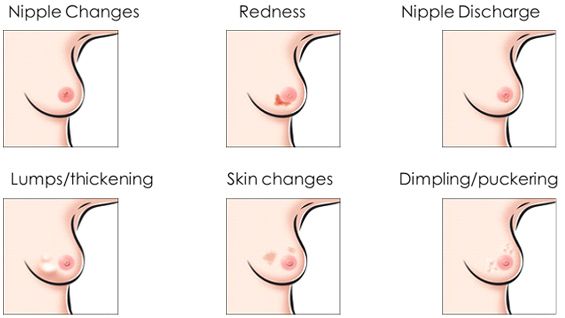
Image used with permission from the Canadian Breast Cancer Foundation
Do young women really get breast cancer?
YES! Here are a few facts about young women and breast cancer:
- Every year, just over 1000 Canadian women ages 15 – 39 are diagnosed with breast cancer. That might not sound like many, but breast cancer is still the most common cancer in young women in Canada.
- Approximately one-third (37%) of all new diagnoses of cancer in women under age 50 are for breast cancer.
- Breast cancer in young women is frequently found at a later stage and can be more aggressive than breast cancer in older women.
What are the risks?
Experts don’t really know what exactly causes breast cancer or why some women develop it while others don’t.
Researchers have found that breast cancer is most likely caused by a combination of different risk factors, some within our control and some not.
A risk factor is something that increases your chance of getting a disease – it does not mean you will get that disease.
Uncontrollable Risk Factors:
Risk Factors We Can do Something About
How are breast cancer and smoking linked?
What are the dangers of cigarette smoke?
Cigarettes may be small, but when they’re burned, they release a dangerous mix of over 7,000 chemicals in to the air – more than 70 are known to cause cancer. People who smoke breathe in these chemicals. But so does everyone else who breathes in second-hand smoke. Some of the more well known cancer-causing chemicals in cigarette smoke include:
On their own, many of these chemicals are poisonous, but they’re even worse when burned together and are definitely not meant to be inhaled! Yuck!
Some of the other health effects of smoking and second-hand smoke include:
- Lung Disease – Girls who smoke or are exposed to second-hand smoke are more prone to delayed lung growth, than boys. This makes them smaller and weaker and more prone to diseases, like colds, bronchitis, and pneumonia as well as other more dangerous breathing problems like asthma. Over time, being exposed to cigarette smoke can lead to more severe lung disease, including lung cancer.
- Heart disease – Cigarette smoke limits the amount of oxygen that enters the blood. This puts stress on the heart by raising blood pressure and making it work harder than it should. Smoking also increases the amount of cholesterol and unhealthy fats in the blood, which clogs the arteries all over the body. Over time, this increases the risk of heart diseases, like heart attacks and stroke.
- Weakened bones and muscles – During your teen years, your bones and muscles continue to grow. Cigarette smoke disrupts this natural growth, leading to loss of muscle strength and function as well as bones to become brittle and prone to fracture.
- Weakened Immune System – The chemicals in cigarette smoke can make your immune system less effective at fighting off infections and less able to heal after illness or injury. This means that smokers and those exposed to second-hand smoke are more likely to get sick and be sick for longer than those who live smoke-free.
Do filters help?
It is true filtered cigarettes stop solid particles from being inhaled. However, filters are powerless against most of the toxic chemicals contained within cigarettes and they give no protection from side stream smoke – the smoke produced from the burning end of the cigarette. Side stream smoke is the main component of second-hand smoke.
What about smoking outside?
Many people think it’s safer to smoke outdoors because the smoke will drift in the wind or people will just move out of the way of the second-hand smoke.
But, in reality, cigarette smoke doesn’t move very far and outdoor levels of cigarette smoke within one or two meters of a lit cigarette can actually be just as high as levels found indoors.
Also, the by-products of smoking (third-hand smoke) stay behind in the nearby area (e.g. on chairs, tables, railings, etc.) even after the person butts out.
What can teens do?
About 1 in 9 Canadian teens currently smoke, with rates similar for both girls and guys. The good news? Smoking rates among teens are the lowest they’ve ever been! And smoking in many public places has now been banned.
But… there are teens who are at risk for starting to smoke and many girls are still exposed to second-hand smoke daily, either at home, in cars, at parties, or on sidewalks and in parks.
Here are a few tips!
Stay healthy! Don’t smoke and avoid second-hand smoke. You have the power to live a smoke-free life!
- Strategies for Avoiding Second-hand Smoke [pdf]
- QuitNow Youth Smart Steps – Girls [pdf]
- QuitNow Youth Smart Steps – Guys [pdf]
Be an ally! If someone close to you (like a friend or family member) is trying to quit, be there for them. You may be surprised just how much they appreciate your support!
Tell others! What you say can have a big influence on the people in your life, so share what you know with your friends and family and help them live a smoke-free life too! If you find this site useful, share it with your friends!
Sources
- American Cancer Society What are the risk factors for breast cancer?
- Canadian Breast Cancer Foundation Breast Cancer Risk Factors
- Lungs are for Life
- The Lung Association: Smoking & Tobacco
- Smokefree Teens
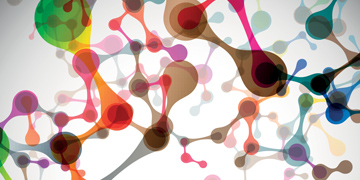
- Quick Navigation
- What is breast cancer?
- Early signs of breast cancer?
- Do young women get breast cancer?
- What are the risks?
- How are breast cancer and smoking linked?
- What are the dangers of cigarette smoke?
- Do filters help?
- What about smoking outside?
- What can teens do?
Smoking and Breast Cancer – What’s the Link?
Video troubles? Here’s the direct link: http://ow.ly/th1Ri


